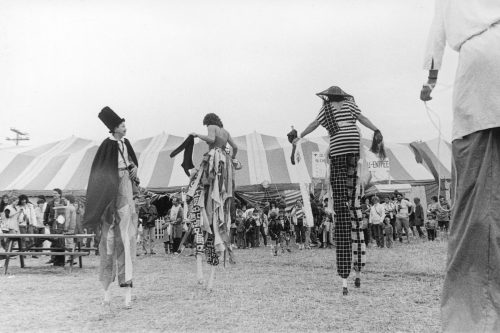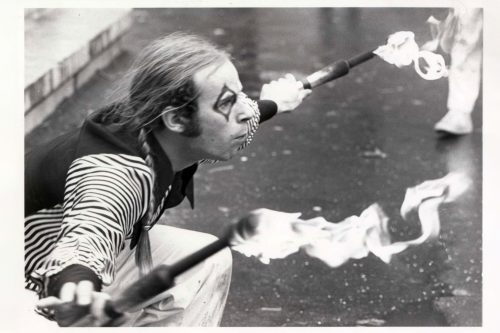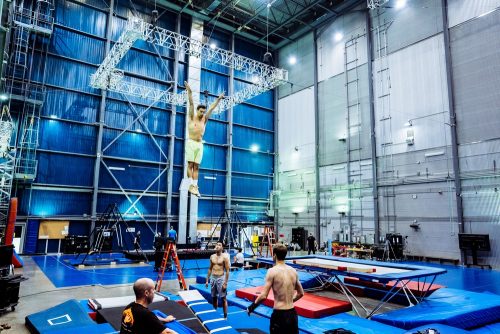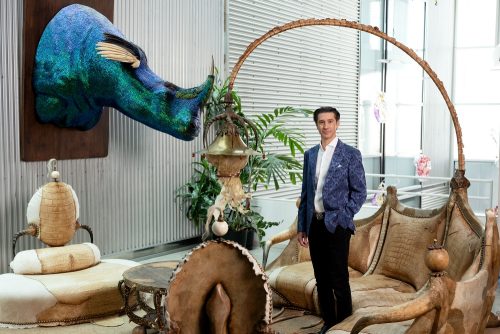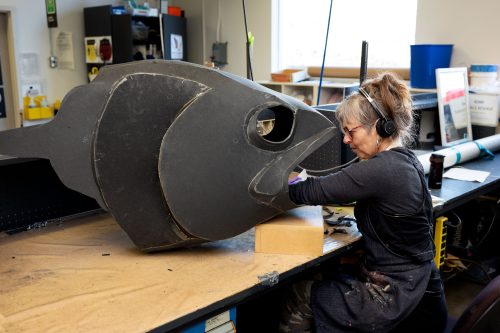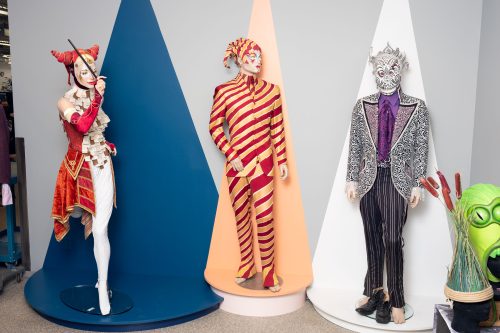Stéphane Lefebvre shifted anxiously in his sky-blue suit jacket and scanned the crowd waiting for the world premiere of Cirque du Soleil’s Echo under the Big Top at Montreal’s Old Port. It was April of 2023, and the Canadian circus troupe was mounting its first new big-tent show since its COVID-era bankruptcy. Lefebvre, the company’s chief executive, was as nervous as if he were one of the acrobats about to dance across a cube suspended over flames rising from below. Probably a lot more nervous.
The CEO had a lot at stake. A $30 million production, Echo had taken three years to develop. And the future of Cirque and its 4,200 employees, including clowns, musicians, acrobats, seamstresses, and creative directors, was riding on the show’s success.
The COVID-19 pandemic—which had forced Cirque to abruptly shut down its productions in Las Vegas and dozens of cities around the world—was a disaster for all live-performance–based businesses, but it couldn’t have come at a worse time for the glitzy, avant-garde acrobatics company, which was in the midst of a rapid, chaotic expansion.
Cirque was larded with $900 million in debt from a 2015 leveraged buyout led by private equity group TPG, which owned 60% and had pushed a relentless growth agenda: more massive shows, in more markets, all while swallowing up other live-performance companies such as Blue Man Group. TPG’s investment thesis was that Cirque’s enormous name recognition and valuable intellectual property meant it could generate a lot more revenue at a time in which Cirque’s top line was stagnating.
But the ambitious strategy left the company stretched thin. Then COVID pushed it over the edge. Over the course of one week in March 2020, Cirque, which had been steadily if modestly profitable, saw its annualized revenue go from $1 billion a year to zero. Its 44 active productions, including several about to premiere, were shut down. Theaters, and the whole company, went dark for the next 16 months. The company laid off 95% of its staff, and by June of 2020 Cirque had sought bankruptcy protection.
Even before COVID dealt its blow, Cirque du Soleil’s story was following a trajectory that is now familiar across industries: A strategy of fast growth focused on scale, scale, scale drives up a company’s value, then it crumbles when that pace proves unsustainable, or leaves the company precariously vulnerable to shifts in the market. Think of what happened to Peloton, the at-home fitness company that boomed during the pandemic but also built manufacturing sites it later didn’t need because of dwindling sales; or unicorns like Bird and Allbirds, whose scooters and eco-friendly shoes, respectively, turned out to be niche markets. As rising interest rates ended the era of cheap money and plentiful investment, all too often these balancing acts have come crashing back down to earth.
For Cirque du Soleil, the fall from grace was especially painful. After 36 years of growth from the circus’s humble beginnings as a troupe of artsy misfits in Quebec, the irreverent, bohemian company had become a household name globally, with its premieres attracting the likes of Barack Obama and Paul McCartney. Cirque’s revenue of about $1 billion just before the pandemic was a staggering amount for what’s essentially a theater company. (By comparison, all of Broadway combined took in $1.6 billion in 2019.)
In its pre-COVID era, Cirque was producing extravagant new shows at a breakneck pace and embarking on an aggressive expansion of its permanent theaters abroad. It had reportedly been looking into making a Hollywood movie based on its O show, as well as a reality show built around aspiring Cirque acrobats. At its height, the company employed 5,000 people and was valued at $1.5 billion. Post-COVID, it wasn’t clear that Cirque, a major source of pride for Quebecers, would hold on to its headquarters in Montreal—or whether it would even emerge from bankruptcy protection.
It did. But by the time the company was purchased by a group of its creditors led by Catalyst Capital Group in a fire sale in November 2020, it was clear that the company had to pivot.
Lefebvre and his boss, Daniel Lamarre (who had been CFO and CEO at the time of bankruptcy and were made CEO and executive vice chairman, respectively, a year later), vowed that Cirque would rise from the ashes. And they decided that while the company still had to grow, the only way to do so sustainably was to go back to its roots—as a traveling circus operating on a more modest, human scale.
Instead of trotting out a massive new production every year, the company would mount new tentpole shows every other year, while creating a slate of smaller, less expensive dinner theater and cabaret productions to take on the road—in part to become less dependent on Las Vegas, where it earned about half its revenue. Beyond the stage, the company would engage with only a few carefully chosen collaborations: a documentary, video games, performances at corporate retreats. And its leaders have vowed that post-bankruptcy, Cirque has no plans to make additional acquisitions.
The key to pulling off this reinvention, Lefebvre says, is to keep Cirque tethered to the irreverent artist-first culture that made it a popular ticket worldwide for decades. “We needed to get the creative spirit back at the center of this company,” Lefebvre tells me at Cirque’s headquarters in Montreal. “If you don’t have the right creative team empowered to work their magic, you won’t get there.”
His approach appears to be working. The credit ratings agency Moody’s Investors Service estimates that Cirque’s revenue had climbed in 2023 back up to the $1 billion mark it had hit before COVID shut it down. Still, the agency said in a research note in March that it expects “revenue growth to moderate” and hover at just above $1 billion, the high-water mark it has long struggled to exceed, for at least the next two years.
After the near-death experience of bankruptcy, Cirque is charting a post–scale-era course for itself that other companies might be well advised to pursue—a model of sustainable growth that doesn’t overextend a business or exhaust its employees.
From street buskers to Vegas sensations
Cirque du Soleil got its start in Baie-St-Paul, a popular resort town an hour’s drive east of Quebec City, in 1984, after the government of Quebec gave a grant to a ragtag group of street performers known for their stilt walking, led by Guy Laliberté, a fire-breather. In exchange for the $1 million ($1.3 million Canadian-dollars) grant, the group, then called Les Échassiers (the stilt walkers), was asked to perform at celebrations of the 450th anniversary of the arrival of French settlers in Canada. That exposure and money allowed Cirque to develop more elaborate shows and go on tour—and to venture beyond its home base.
Business savvy combined with artistic flair—a balance between the left and right brain—was built into Cirque’s DNA from the very beginning. Laliberté, now 64, is an eccentric with a bohemian heart who had famously busked through France as a student, playing his grandfather’s accordion. But he was also the son of a prominent executive at Alcan, the giant aluminum company based in Montreal.
Cirque’s spectacular acrobatics paid homage to circus traditions going back centuries, while spinning them into a new art form. The shows ditched the animal acts and disconnected stunts of the Ringling Bros. and Barnum & Bailey circus tradition and offered an elevated, story-driven form of theater, with original new age music, dialogue in a made-up language, and outlandish costumes. The plotlines each addressed some specific aspect of human existence but were broadly relatable enough to play well to audiences anywhere: Alegría, in 1994, was about the struggle of young people to renew a society. Quidam, in 1996, grappled with the feeling of being a nobody, and Kooza, from 2007, centered on a group of misfit characters looking to carve out a place for themselves.
By the late 1980s, Cirque had built some buzz with a show in Santa Monica. That caught the attention of casino moguls—and in the early 1990s, Cirque came to dominate Las Vegas. The arrival of Cirque’s elegant yet edgy shows proved integral to Sin City’s transformation from a mecca for gambling and vice to a hub of high-end entertainment. (The typical ticket price for a permanent Cirque show is $113, while a touring show’s tickets go for $86.)
Major casino developers including MGM and Wynn built large venues for the shows, and Cirque produced hit after hit after hit. Indeed, Cirque’s water-centric O production, performed in a 1.5-million-gallon pool at the Bellagio, has been a fixture in Vegas since 1998, and a cash machine that has raked in $2.6 billion in ticket sales—and still fills 94% of its seats. The troupe’s ode to the Beatles oeuvre, Love, has also played to full houses since 2006, though it will close this summer.
Too many tricks
In 2015, Laliberté sold all but 10% of his majority stake in the company, and over the next five years, while Cirque was owned by a group of investors led by TPG, Lamarre and Lefebvre were under orders to aggressively grow and professionalize Cirque. There was even some chatter of a Cirque IPO before COVID struck. (TPG declined to comment for this story.)
The two men—CEO and CFO at the time—take responsibility for their role in Cirque’s financial woes, and concede that they bought into the private equity firm’s strategy. But both say that the pressure from accelerated growth took a toll on the artists who make Cirque shows dazzle. “I want to be careful with the words I am using, but clearly a change of culture happened,” Lefebvre recalls. “We went from a place of close cooperation to worrying about ‘Let’s build it quickly, let’s prime the pump.’” In other words, it became harder to keep the suits at bay.
Cirque’s growth had slowed in the early 2010s, and there was a sense that its formula was at risk of getting stale, that some of the buzz was gone because of a certain sameness, show after show: acrobats, clowns, new world music, and outlandish costumes. For any arts-based company, creative renewal remains a perennial challenge, especially given the pressure to grow. “There is this pitfall that at some point people start to think, ‘I’m watching the same thing over and over,’” says François Colbert, a professor of management of cultural enterprises at business school HEC Montréal. “The Cirque has to find the right balance between taking creative risks and not having flops.”
2019 was a hectic year for Cirque: It launched six new shows, large and small, the most ever in a single year, all while trying to create its first permanent China show in Hangzhou. That year, Cirque endured a rare flop, illustrating the perils of straying too far from its successful formula: R.U.N., modeled on live-action thrillers, featured scenes of simulated torture that were way too much for Cirque-goers looking for death-defying acrobatics rather than meditations on the human potential for depravity. One online reviewer said he was “horrified” by the torture, adding that the show was “a confusing cheesy mess until the end. Nothing makes sense.” The show was shut down by COVID and never reopened.
In addition to creating more of its own shows, Cirque’s owners and brass were trying to turn Cirque into something of a studio that would create spectacles for other entertainment companies as well. And Cirque wanted to expand its division handling corporate events such as team-building retreats for clients like Adobe. (It still offers bespoke productions, such as the show recently performed at the pre-wedding celebrations of Indian industrialist Anant Ambani and Radhika Merchant, at which pop star Rihanna also performed; or the occasional custom-made outfit, like the Halloween costume designed for model and TV star Heidi Klum in 2023.) Adding to the company’s stress, Cirque made a number of acquisitions, notably performance-art company Blue Man Group in 2017 and later, kids entertainment firm VStar, as well as magic-show creator The Works—despite never having been a portfolio company. (Cirque says Blue Man Group is now doing “very well.”)
The TPG strategy could have ultimately worked if not for COVID, Lamarre and Lefebvre say now. Indeed, much of their current strategy echoes that previous private-equity–driven playbook, albeit at a more measured pace. But paradoxically, the pandemic that almost killed Cirque du Soleil may have also saved its soul.
Two ‘suits’ among the clowns and acrobats
Lamarre, a media and PR executive who joined Cirque in 2001 and became CEO in 2006, working hand in glove with Laliberté, acknowledges the awkwardness of being a “suit” in a company full of clowns and artists. It’s a well-known story at Cirque that Laliberté found Lamarre a bit stiff initially, so he assigned him his own clown, Madame Zazou, to follow him around to staff meetings for a few months and act like a court jester to get him to loosen up.
Lefebvre himself is a bit of a suit who spent 19 years as a finance executive at an aeronautics firm before joining Cirque. Now, as he builds what he is optimistically calling Cirque’s “second golden age,” he too has struck up a friendship with Laliberté, who is a business icon in Quebec and has remained a colorful character, even traveling to the International Space Station in 2009 as a space tourist (wearing a red clown nose during liftoff).
Laliberté no longer holds any formal role or stake in the company—in a stroke of good timing, he sold his 10% stake in Cirque just weeks before the COVID lockdowns—but he has taken on the mantle of Cirque’s patron saint, sharing his impressions of Cirque productions while they are in development. When Lefebvre first spoke as CEO with the founder in 2022, he pledged to be a good steward for a company whose international success is a major source of pride in Quebec: “I will do everything I can to look after your baby, or die trying,” he recalls telling Laliberté.
That was a promise that might have felt necessary because Lefebvre, 56, doesn’t come off as the circus ringleader type. A slim, athletic man with a full head of hair who favors blazers, he attends about 10 Cirque shows a month but says he avoids micromanaging the artists who make Cirque’s magic. “My contribution is never about, ‘I think the red costume should be blue.’ That would be the biggest mistake,” he notes. (Lamarre made the same point: “The show is the star,” he says, like a mantra.)
Lefebvre doesn’t have his own clown, but Madame Zazou still sometimes appears at all-staff meetings to bring levity and keep the workforce grounded in the company’s foundational culture.
A new, more agile Cirque starts a new era
On a cold February morning at a campus about six miles from downtown Montreal, Cirque’s sprawling headquarters, which bears the slogan “Le soleil se lève à nouveau,” (“The sun is rising again”), is humming with activity: acrobats trying new moves in its massive gymnasium, seamstresses creating costumes, and performers applying makeup themselves. While a work-from-home policy and smaller headcount have made the complex less bustling, it’s clear that the Cirque has some pep in its step again.
It’s a testament to Cirque’s strong culture and the loyalty it has earned that it managed after the bankruptcy to quickly hire back dozens of its seamstresses, shoemakers, and mask makers—70% of those artisans—to resume shows in 2021. That year, Cirque started reopening its Vegas blockbusters; O and Mystère returned, supported by an ad campaign proclaiming: “Intermission is over.”
Staying true to its culture is essential to Cirque in its next chapter, observers said. “DNA doesn’t change, but it adapts, and this team has integrated Cirque’s DNA,” says the Montreal-based corporate historian Louis-Jacques Filion, who has studied Cirque extensively.
Cirque’s trainers even persuade me to take a spin in a cerceau, a large hoop to which I am fastened as I’m promptly lifted 60 feet into the air, as well as an exhilarating ride in the German wheel. For the latter, I had to practice shifting my weight to give the wheel momentum, something that deepened my appreciation for the incredible core strength these performers possess.
The new post-COVID strategy for the company is coming into focus: Cirque is preparing for an upcoming country-music-themed show titled Songblazers that will launch in Nashville in July then travel to other U.S. markets. It is planning to build a permanent theater in London and will begin construction on one in Hawaii later this year. “The phones keep on ringing, and people want to work with Cirque,” says chief financial officer Emmanuelle Leclerc-Granger.
Long before any pushy investors showed up, the Cirque had been trying to figure out how to generate extra revenue beyond pure ticket sales. Under new owner Catalyst Capital, managing director Gabriel de Alba says Cirque will be given time to rebuild carefully—but he is eager to say that the brand has not been fully tapped, echoing TPG’s view that there’s still room to grow the company’s brand and offerings.
Cirque has to proceed gingerly and not flood the zone with new shows—partly to avoid jeopardizing quality and originality, but also to maintain the scarcity that is necessary for Cirque to thrive as “the luxury-identified experience” de Alba says it is.
De Alba is keenly aware that there is a lot more competition out there for entertainment dollars, particularly in Vegas, where Cirque still hosts six permanent shows: In that city, there are a lot more sports offerings, as well as fine-dining and entertainment options, than when Cirque first took it by storm in 1993. And others have built upon Cirque’s success, including several new small circus companies, such as Spiegelworld.
Artistic freedom, within reason
In the nearly three years since Cirque reopened, business has rebounded quickly. Moody’s has upgraded Cirque three times. (Its debt is still junk-rated, and in its most recent credit opinion in March, Moody’s maintained this rating, citing slow growth after that fast post-COVID rebound.) More crucially, Cirque sold 11 million tickets to its shows last year, compared with 10 million the year before the pandemic.
Still, despite the Chapter 11 filing, Cirque remains saddled with $550 million in debt, meaning it has to tread carefully. And therein lies Cirque’s tough balancing act: Caution and risk aversion can be anathema to creativity.
“If you have a great show, you’ll have a great business,” Lamarre has liked to tell Cirque’s owners over the years. “So I say, let our creators do what they do best, but within a sandbox, and in that sandbox they have total freedom.”
In his 2022 book, Balancing Acts, Lamarre wrote that Cirque audiences wanted “acrobatics, acrobatics, acrobatics.” But today, he insists that audiences will accept other elements. ”It’s not just acrobatics they want: What people are looking for is human performance,” he says. There are signs that Cirque is starting to figure this out: Mad Apple, resident at the New York–New York in Las Vegas since 2022, is a mix of cabaret, dancing, and humor, and is playing to 80% full houses, on par with historical averages.
After the 2020 trauma, Cirque is determined to become less reliant on live performances. Later this year, it is premiering an IMAX-like movie theater experience called Cosm, and it is planning various TV projects, potentially including a reality show. It has also been testing the waters of video games in partnership with virtual reality platform Roblox, via Cirque du Soleil Tycoon, in which players can create their own Cirque show. The video game, along with a social media influencers group, is part of a big push to attract a younger audience: The average Cirque-goer is 42.
What’s more, de Alba says, there has long been an untapped opportunity to get more out of visits to its shows than the $113 price tag. De Alba says Cirque has typically earned an average of just $2 in additional revenue per visitor per show, from such ancillary sources as T-shirt sales and drinks, compared with the $30 average at rock shows. So at the Montreal premiere of its Kurios this spring, the updated return of a production first shown in 2014, Cirque will begin testing an idea similar to the preshow VIP meet-and-greets that have proved a boon for the concert industry: early access to the front-of-stage with treasure-hunt–like activities and perhaps a glass of prosecco.
It is also testing out licensing efforts, such as the recently announced partnership with whisky maker Macallan, which involves a small-scale Cirque show just for Macallan’s estate in Scotland.
As much as these licensing deals can help diversify Cirque’s revenue, its bread and butter business will be live entertainment for a long time to come, and there is ample reason for optimism.
In Montreal, Echo was a box-office hit, selling 300,000 tickets, a sales record in its hometown, a year after Cirque’s Kooza had also broken records for the company there. Echo has since visited Atlanta, Miami, and the Washington, D.C., area to similarly large crowds.
Days before the official Echo premiere last year in Montreal, hundreds of Cirque employees were given an exclusive preview of the new show, as is the company’s longtime custom. The Cirque staff gave their colleagues an ecstatic three-minute standing ovation, recalls Lefebvre. But the real test would come with the premiere before a paying audience.
After the curtain call at the debut, Lefebvre hugged his performers and exhaled. “Everyone under the Big Top at the moment felt a sense of pride and relief,” he says. “Knowing that we were officially back.”
{ SOURCE: Fortune }
